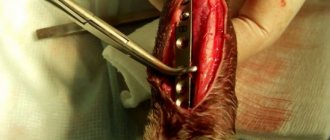Continuous contraction of muscle fibers under the influence of negative factors is considered to be a cramp. During a cramp, the muscle is severely cramped and cannot relax. Prolonged compression of a muscle group has a strong effect on nerve endings. This is the cause of acute pain.
Not only people, but also pets are at risk. The occurrence of seizures in most cases is associated with the development of a dangerous disease.
This article provides information on what symptoms of seizures exist in cats and cats, and possible causes. We will also tell you how to help your pet in this situation.
What are the symptoms of seizures
Many people have experienced muscle cramps, which cause severe pain. Similar sensations are typical for pets.
The photo shows an example of seizures in a cat. At the moment of this, the animal moves its legs randomly. It happens that a cat’s paws are very tense at the time of an attack, gathered under the tummy.In appearance, the cat looks scared. When in pain, she begins to make loud noises and does not allow people near her. The pet also has dilated pupils.
If there is pain in the hind legs, the cat may fall to the floor and not get up.
In a severe situation, the cat may foam at the mouth or be capable of involuntary bowel movements. Due to pain, the animal does not always recognize its owner.
It happens that cats begin to show aggression during a seizure. When the attack ends, the animal becomes calm and behaves as before.
How to vaccinate rabbits yourself at home
Sometimes it is not always possible to vaccinate a rabbit at a veterinary medical institution. Especially if it concerns a large population. And the cost of veterinary services is not cheap. To avoid excessive stress for the animals and save money, rabbit breeders vaccinate themselves at home.
Vaccination is a serious procedure that, when performed independently, requires compliance with certain instructions.
Need to:
- carefully study the instructions for use of the immunobiological agent;
- check the timing and strictly follow the rules for storing the drug;
- strictly adhere to the instructions for the administration technique;
- control the air temperature to prevent the animals from overheating.
For novice breeders, it is recommended to take an assistant who will hold the animal. The medicine is injected into the withers, thigh or ear of the rabbit using a disposable syringe, automatic syringe or ear injector. Experienced breeders prefer to inject the drug into the thigh - intramuscularly. Before giving the injection and after the procedure, the injection site is wiped well with alcohol.
To support the animal after vaccination, it is given vitamin and mineral premixes, immunostimulants, fish oil, pumpkin, sprouted grains, and rowan.
Video VACCINATION OF RABBITS
Determining the basis of seizures
Often, owners have to think about what could be the cause of a cat’s seizure. Only an experienced veterinarian qualified in this field can make a correct diagnosis.
Before the causes of seizures in an animal are established, it is necessary to allocate the necessary time to study its body. The veterinarian obliges you to donate your pet’s blood for analysis and take a chest x-ray.
To check your vital organs, you will also need to do an ECG of the heart, an ultrasound of the abdomen, and an MRI of the brain.
Due to the fact that such an examination takes a long time, the doctor prescribes anticonvulsants, which must be given to the cat to reduce the risk of new seizures. The dose of the drug is determined based on the age and weight of the animal.
What vaccinations do rabbits get?
There are vaccinations that are included in the mandatory list and there are those that are optional (based on the epidemiological situation).
Mandatory vaccinations
They are introduced according to a special schedule approved in accordance with the article of the Law of the Russian Federation “On Veterinary Medicine” dated May 14, 1993 No. 4979 and the order of the Ministry of Agriculture of the Russian Federation dated December 12, 2017 No. 624 “On approval of Veterinary Rules aimed at preventing the spread of VGBV.”
The mandatory list includes means to protect against myxomatosis (the so-called “mosquito vaccination”) and vaccines with antibodies to hemorrhagic lesions.
Optional vaccines
Vaccinations against pasteurellosis, salmonellosis, listeriosis, and paratyphoid fever are not considered mandatory. The veterinarian decides whether they are worth carrying out, based on the local epidemiological situation. According to the testimony of a specialist, optional vaccinations are administered at the age of 30-45 days, 14 days after the introduction of previous prophylactic agents.
Possible cat diseases accompanied by seizures
In most cases, seizures occur when the animal has epilepsy. But, there are other ailments in which muscle spasms are observed.
Among these diseases are:
- metabolic failure in the body;
- a brain tumor;
- severe poisoning of the body.
Often, seizures are a consequence of complications of various kinds of infectious diseases, such as toxoplasmosis or fungal tissue infections. There are many diseases of the central nervous system accompanied by brain damage.
Polycystic kidney disease in cats - causes, diagnosis and symptoms of the disease. Treatment options and prevention of kidney disease (95 photos)- Tartar in cats - signs of the disease and methods of fully treating tartar (125 photos + video)
Ascites in cats - first causes, treatment, symptoms and step-by-step description of the development of the disease (105 photos)
Seizures can occur when there is a deficiency of glucose in the blood. They appear as a result of a long course of liver disease.
A low concentration of calcium in a cat's body may be the basis for the onset of seizures. A disease called hypocalcemia often begins along with renal and endocrine diseases.
A lot of reasons can lead to an attack of convulsions, ranging from poisoning of the body with various groups of substances and ending with intestinal parasitic diseases.
It is possible that a cat may begin to have seizures due to thyroid disease. From the entire list above, it becomes clear why a cat may experience seizures.
Causes
In order to select the correct and high-quality treatment, a specialist at a veterinary emergency center must first determine the reasons for this behavior of the animal’s health condition.
Possible reasons :
- One of the reasons may be epilepsy, which is a complex neurological disease. This diagnosis is made if other causes have already been excluded. First of all, after a specialist from the veterinary center conducted a thorough examination, he took a urine and feces test. He also conducted neurological examinations, an examination of the back of the eye, and monitored the general condition of the pet over time.
- As a result of metabolic disorders, various pathologies of organs, their failures, hypokalemia, hypocalcemia, as well as toxoplasmosis.
- Poor heart function.
- Parasites present in the intestines can also be causes.
- A variety of infectious diseases that are caused by bacteria, viruses and fungi.
- Tumors.
- If the animal is poisoned by chemicals.
What can be helpful for a veterinarian?
Depending on how extensive and reliable the information about a cat’s seizure is provided, the veterinarian will be able to quickly diagnose the disease and prescribe the necessary therapy.
The doctor will need to know how long the seizure lasted, what intensity the muscle spasms were, and whether the cat had seizures during sleep or while awake. Have you been treated for this before, and if so, what kind?
Diet also plays an important role. If your animal eats raw meat and fish products, you should tell your doctor about it.
So, at the moment of a convulsion, the cat needs help. The next day or in the near future, you need to show your pet to a doctor.
After the prescribed treatment, you must comply with all dosages of the drugs, and if side effects occur, immediately seek medical help.
At what age should vaccinations be given?
An important point when vaccinating rabbits is their age. It is recommended to start carrying out preventive measures at 45 days (if the baby rabbit’s body weight is more than 500 g), and then after 90 days and 180 days. All subsequent vaccinations are given every 6 months.
Until 45 days of age, eared babies are protected by antibodies that they receive from their mother's milk. Next, their body loses its immune maternal protection and becomes susceptible to pathological infection. Therefore, rabbits begin to be vaccinated at this age. But if the local epidemiological situation is unfavorable and there is a risk of infection, vaccination begins at 21-30 days of age.
The selection of the type of vaccination, the schedule for its administration and the procedure is carried out by a veterinary specialist!
Photos of seizures in cats
Read here Anemia in cats: main causes, symptoms, treatment options and best medications (90 photos)
Help the site, share with friends 
2
Vaccination scheme
Depending on the age, procedures for vaccination and revaccination of rabbits are carried out alternately. For babies who have not gained the required weight, vaccination is postponed. WITH
The cost at the clinic is 200-400 rubles.
| Age | Vaccine | Route of administration and dose |
| 28-30 days | Myxomatosis | 1 cube intramuscularly |
| 1.5 months | VGBK | 0.5 cc intramuscularly |
| 3 months | Solikoks (against coccidiosis) | Per 1 kg 0.4 ml with food (2 days in a row) |
| 4 months (and every six months) | Myxomatosis (revaccine) | 1 cube intramuscularly |
| 4.5 months (and every six months) | VGBK (revaccine) | 0.5 cc intramuscularly |
| 6-7 months (and annually) | Rabies | As recommended by your veterinarian |
Vaccines and the cold chain: maintaining the cold chain
The Infectious Disease Bulletin focuses on factors influencing the quality of the Dutch national vaccination program [ 1 ]. The conditions for transporting the vaccine from the manufacturer to the final consumer are very important. This path is usually called the “cold chain”. If the chain is too “weak,” it may break, rendering the vaccine ineffective. The World Health Organization's extensive Immunization Program has for many years focused on maintaining the cold chain, mainly in tropical and subtropical countries. Thus, in Nigeria, differences in seroconversion rates after measles vaccination at two vaccination centers in Nigeria were found to be largely due to vaccine handling [2]. In the 80s, this type of research began to be carried out in Europe. An inventory study was conducted in Holland in 1990 [3]. In the UK, a survey of family doctors found that in many cases the refrigerator used to store vaccines was not equipped with a thermometer and that multi-dose vials were often used for much longer than 24 hours, sometimes up to a month after opening [4]. Therefore, a limited study of vaccine use in 33 Dutch consultation offices was carried out. It turned out that most vaccinating authorities have problems with storing vaccines [5]. Based on the results of this study, “Recommendations for handling vaccines” were compiled; In the spring of 1993, a “Cold Chain Symposium” was held.
Why cold chain?
Vaccines are heat labile products and must be handled with care to maintain their properties. During the preparation of vaccines, requirements are strictly observed to ensure consistently high quality of the final product. These requirements are known as GMP (good manufacturing practice). One of these requirements relates to the storage conditions of vaccines at the manufacturer. Once the vaccines are handed over to the recipient, he becomes responsible for their proper storage and/or further transportation in the case of, for example, supplying a wholesaler or provincial vaccination organizations. Vaccines should be stored in their original packaging in a dark place at a temperature between 2 and 80°C. Only in this case is the preservation of their quality guaranteed until the expiration date indicated on the packaging. Each deviation from these requirements damages the quality of the vaccine and shortens the period of possible use.
Effects of too high temperatures When a vaccine is exposed to too high temperatures, the protein structure of the antigens can be disrupted, leaving less antigenic material in the vaccine. Live vaccines reduce the viability and infectivity of weakened pathogens, which are necessary for a good immune response. After using vaccines that were stored at too high temperatures, immunity will be insufficient or completely absent.
Consequences of too low temperatures
Lyophilized vaccines themselves can be preserved without damage at too low temperatures, but the diluent may become contaminated as microscopic cracks may appear in the wall of the bottle due to the expansion of the freezing liquid. The contents of these bottles cannot be used as a diluent for lyophilized vaccines. When storing liquid vaccines, the same problems arise as when storing solvents. In addition, in adsorbed vaccines such as DSP and DXP, freezing may destroy the bond with the adsorbent. The formation of flakes is typical; the vaccine cannot be shaken until homogeneous. Adsorption affects the effectiveness of the vaccine; after freezing, the immunogenicity of the vaccine is greatly reduced. Due to breaks in the cold chain, thousands of guilders worth of vaccines are lost every year. In these cases, it does not make sense to determine the effectiveness of the vaccines in all affected lots, since this would be significantly more expensive than replacing the vaccines. It is easy to assume that cases of breaking the “cold chain” are not always noticed. In such cases, vaccination is carried out, but immunity does not occur, and then an unfair conclusion may be made that the vaccine has failed. This alone makes good vaccine storage organization very important. This article examines the practical aspects of maintaining a “cold chain” and provides advice on organizing vaccine storage. Recommendations are given on how to handle vaccines if there is a break in the cold chain. Our advice can be used not only by those who carry out the state vaccination program, but also by vaccine sellers and everyone who vaccinates.
Vaccine stock: organization and responsibility
Each organization that owns vaccines should have a written protocol for storing vaccines and ensure that one person is responsible for storing vaccines. This person is responsible for enforcing storage regulations and can be called upon in the event of a disaster.
Fridge
A large stock of vaccines (for example, a bulk shipment) is usually stored in a large refrigerated facility, often custom-built and equipped with electronic monitoring and control systems. A smaller supply of vaccines (for example, available from a pharmacy or vaccination provider) can be stored in a regular home refrigerator. It is advisable that this refrigerator does not have a freezer compartment and an automatic defrosting system. If there is a freezer, there is a high probability that the vaccine may freeze in some areas. In addition, a refrigerator without a freezer can be defrosted and cleaned faster. An auto-defrost refrigerator regularly raises the temperature to allow frozen liquid to melt and drain. These frequent temperature fluctuations have a negative impact on the quality of stored vaccines. It is better to defrost the refrigerator yourself periodically. It is recommended to have two refrigerators for storing vaccines. One refrigerator should be in the reception area to store a day's supply. This refrigerator has to be opened regularly, which leads to unwanted temperature fluctuations, but this is not so significant since its contents are used up quite quickly. Another refrigerator is used to store supplies and it is advisable to open it no more than once a day. If you have several refrigerators, you must ensure that they are not connected to the same electrical group; If one fuse blows, the entire supply is lost. Do not store other items in the refrigerator that contains vaccines and medications. since in this case the refrigerator will open more often, which again will lead to unwanted temperature fluctuations. In addition, storing food in the refrigerator increases the likelihood of contamination and microbial growth, causing the refrigerator to have to be defrosted and cleaned more often. Do not place the refrigerator in direct sunlight or close to a heat source. In winter, the temperature in the room where the refrigerator is located should not fall below 100°C: this may impair the operation of the refrigerator. It is not advisable to set up a vaccine warehouse in places that are rarely visited by personnel (for example, once a week) if it is not possible to install an electronic monitoring system. It is better to store supplies in a room where someone is always present, and take a small amount with you each time in a portable refrigerator (so-called camping models that operate on 220 V of a 12-volt car battery and sometimes on gas) or in a good refrigerator box with refrigeration elements. In this case, ensure that there are sufficient frozen refrigeration elements and do not allow them to come into direct contact with the vaccines. It is important to ensure that the refrigerator is not overloaded. To maintain a constant temperature, free air circulation is necessary. Do not place vaccine boxes against the walls; leave approximately 2 cm of free space around them. The refrigerator door and vegetable drawer are not suitable for vaccines because the temperature here is often higher than the rest of the refrigerator. If the refrigerator has a freezer compartment, it should be separated with plastic to prevent ice from forming outside the freezer compartment and freezing the vaccine supply. In the latter case, it is recommended to place lyophilized vaccines as close to the freezer as possible.
Defrosting the refrigerator
While the refrigerator is defrosting, the vaccine stock should also be kept chilled. If there is a second refrigerator at the correct temperature, it is preferable to place the vaccine stock in it. If it is not available, then the vaccines are placed in a refrigerator box with refrigeration elements. You can also leave vaccines in the refrigerator to defrost. In this case, the refrigerator door must be closed during defrosting, and care must be taken to ensure that the thawed water does not wet the vaccines. Set the thermostat control to zero (you should first record the thermostat setting in your diary). With a closed refrigerator without a freezer, any existing ice will melt in about an hour, and the refrigerator can be washed according to the instructions in the usual way (a small amount of water and detergent is almost always sufficient). After washing, the thermostat regulator is returned to its original position and the supply of vaccines is again placed in the refrigerator.
Temperature monitoring: diary
Keeping vaccines in the refrigerator does not guarantee that they are actually being kept at the correct temperature. Careful monitoring of temperature changes in the refrigerator is necessary. If equipment breaks down, it is important to know how long it takes to reach certain temperature indicators. A modern, but expensive way to solve this problem is an electronic temperature monitoring system, which sounds an alarm if the temperature rises or falls beyond preset limits. This system also allows you to detect a power outage in time. If the system breaks down, it generates an alarm, for example a telephone warning is sent to one or more employees. In addition, such a system makes it possible to record the temperature on paper, which allows you to retroactively control how exactly the temperature changed. A simpler and cheaper solution is to read and record the temperature and its extreme values daily (ideally also on Sundays and holidays!). You can use a so-called minimum-maximum thermometer, which is sold at a home improvement store. These thermometers have two bars that indicate the highest and lowest temperatures reached since the thermometer was set to zero. These thermometers should be checked before use and then re-checked periodically, for example once every 6 months. For this purpose, the thermometer can be placed in a jar with water and melting ice; in this case it should show 0°C. If there is a deviation, you should write down in the diary and on the label that is stuck on the thermometer by what amount you need to adjust its readings. The results of each test should also be recorded in a diary. Attention!
Many thermometers contain mercury. If replaced or damaged, mercury thermometers should be treated in the same way as chemical waste.
Using a Minimum-Maximum Thermometer • Place a calibrated minimum-maximum thermometer in the center of the refrigerator, level with the vaccines if possible. • Read the thermometer daily, preferably at the same time. When the mercury column rises, the columns rise to the top and continue to “hang” if the mercury falls again. The bottom of the bars indicates the minimum and the top the maximum temperature. • Record your minimum and maximum temperatures in your diary. • After reading the readings, set the thermometer to zero (most often done by pressing a button between the temperature scales) and place the thermometer back in the refrigerator. Do this quickly (within 1-2 minutes), otherwise the thermometer will heat up too much and the next time it is read, the maximum temperature will be incorrect. • Write down in your diary when cleaning and defrosting were done, when repairs were made and what kind. • Record in your diary when new vaccines are delivered. Be careful as vaccines may be delivered from the same batches as previous ones, and in some cases even older ones. • Conduct a monthly inventory of vaccine stock, recording lot numbers and ensuring that the oldest vaccines are used first. • Remove vaccines immediately after expiration dates.
When is it necessary to take action?
• The refrigerator operates normally as long as the minimum temperature is above 20°C and the maximum temperature is below 80°C. • If a slight deviation is detected (the minimum temperature is above 0°C and the maximum is below 100°C), then the refrigerator should be adjusted and its operation should be constantly monitored. • If the deviation is greater (minimum below 0°C or maximum above 100°C), immediate action must be taken. The cause (for example, a power outage) must be identified and eliminated, and if necessary, a technician can be called. It is better to replace an old refrigerator, because if it is “older” than 10 years, then replacement is often cheaper than repair. Take into account the mistakes of others in your work and take care that they do not repeat themselves. Thus, in one clinic, a cleaner pulled the plug of the refrigerator from the socket in order to turn on the vacuum cleaner, and one employee of the consulting bureau did the same to ensure that the refrigerator did not create interference during a hearing test. Ensure that the plug is securely connected to the socket, for example by securing it with adhesive tape. It is important to have enough outlets for all purposes.
What to do after a “chain break”
If a significant storage failure has occurred, the owner of the vaccines must determine whether the vaccine stock in the refrigerator can still be used. Recommendations for vaccines included in the state vaccination program are given in the table. During transport from manufacturer to consumer, it is not always possible to prevent a momentary break in the cooling circuit, so weigh the advisability of, for example, repacking and postage. Since it is usually not possible to determine whether a vaccine has been exposed to heat during transport, the table provides fairly strict guidelines to ensure good quality. Recommendations for freeze-dried vaccines are based on the assumption that they are stored unprepared for use. Once prepared for use, the shelf life is limited; more detailed information is contained in the insert. Opened multi-dose bottles should always be used within 24 hours and then disposed of normally. When determining the duration of the disturbance and the temperatures reached, it is necessary to assume the worst-case situation. If, for example, on Friday the thermometer showed a normal temperature, and on Monday it turns out that during this time the maximum temperature rose to 21°C, then you need to act on the assumption that the vaccines were at a temperature of 21°C for more than 48 hours, although the likelihood that a well-insulated refrigerator will slowly rise in temperature. The entire stock of vaccines must be replaced, only then can the effectiveness of vaccination be guaranteed.
Conclusion
It is necessary to pay due attention to the organization of vaccine storage. If stored incorrectly, there is a need to destroy vaccines if they are detected in a timely manner (economic damage), and if not detected, there is a high risk of insufficient immunization.
Table. Handling vaccines in violation of storage conditions.
| Duration of violation, h | Vaccine | Extreme storage temperatures, °C | |||||
| <0,0 | 0,0-9,9 | 10,0-14,9 | 15,0-19,9 | >20,0 | |||
| less than 24 | DKSP | A | N | IN | IN | A | |
| Chipboard | A | N | N | IN | A | ||
| EpKK/Hib | WITH | N | N | IN | A | ||
| 24-48 | DKSP | A | N | IN | A | A | |
| Chipboard | A | N | IN | IN | A | ||
| EpKK/Hib | WITH | N | IN | A | A | ||
| more than 48 | DKSP | A | N | A | A | A | |
| Chipboard | A | N | A | A | A | ||
| EpKK/Hib | WITH | N | A | A | A | ||
Note.
DKSP - diphtheria, whooping cough, tetanus, polio;
DSP-diphtheria, tetanus, polio; EpMC/Hib - mumps, measles, rubella/Haemophilus influenzae type B; other vaccines: -liquid vaccines - act as with DSP; -lyophilized vaccines - act as for EPA/Hib. N - no harm; A - no longer use; B - use as soon as possible, and store properly before that; C - the vaccine can be used. The solvent bottle can be used as long as there are no signs of leakage or cracks are visible (microscopic cracks may be caused by water expanding when it freezes). If there are cracks, including microscopic ones, then the contents of the bottle may become infected; in this case it cannot be used. The recommendations given in the article are based on the research results cited in the introduction. By following our tips, you can check whether vaccine storage is well organized or if improvements are needed.
Abstract:
Recommendations are provided for the organization of optimal storage and use of vaccines in daily practice.
Literature:
1. Rumke NS. Good clinical practice in het Rij ksvaccinatieprogramma? Infectieziekten-Bulletin 1993:4:277-9. 2. Onoja AL, Adu FD, Tomori 0. Evaluation of meats vaccination program conducted in two separate health centers. Vaccine 1992:10:49-52. 3. Battersby A, Garnett A. Storage and transport of vaccines. Background and study protocol. Report on a visit to the Netherlands, 17-22 June 1990. Geneve: World Health Organization, 1990. 4. Hunter S. Storage of vaccines in the general practice. BMJ 1989:299:661-2. 5. Keja AE, Van Steenbergen JE. De koude keten: zit het venijn in het staartje? Infectieziekten-Bulletin 1993:4:8-11. This article was previously published in Infectieziekten-Bulletin 1993:4(13):280-4 and Tijdschrift voor Jeugdgezondheidszorg 1994;26(2):21-4. Adapted from Pharmaceutisch Weekblad 1995; 130:704-8 with the permission of the main editors, authors and publishers.











